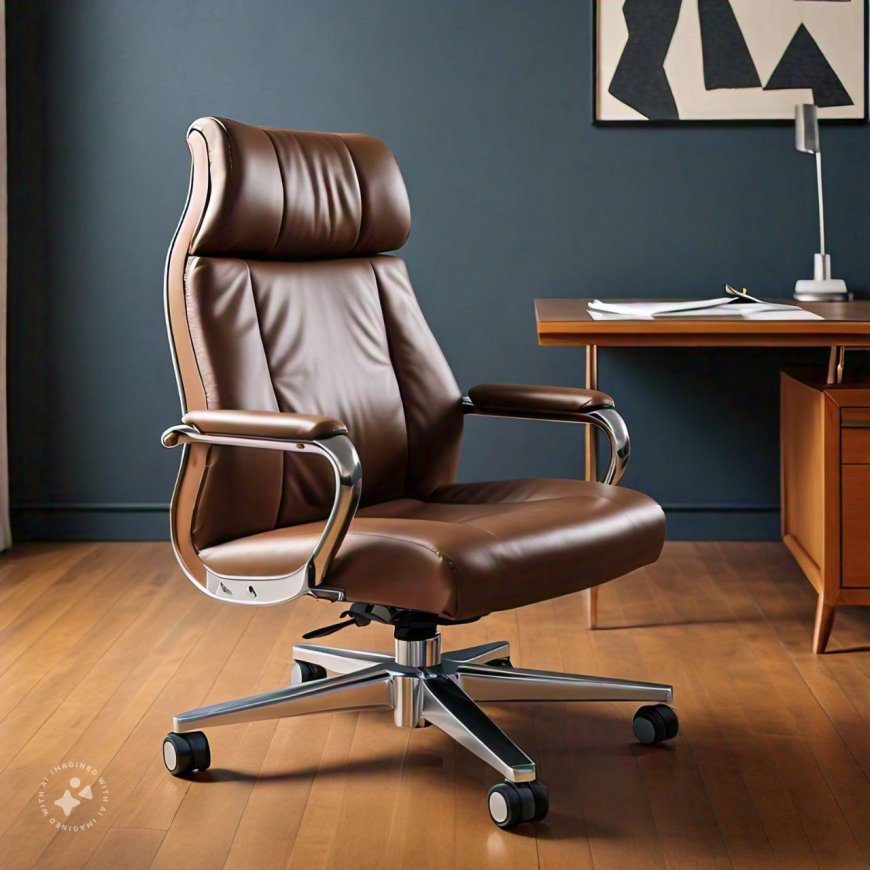Ergonomic Office Chairs: A Buyer's Guide to Comfort and Productivity

In today's fast-paced work environments, where many professionals spend the majority of their day seated at a desk, the importance of ergonomic office chairs cannot be overstated.
These chairs are designed to provide optimal support and comfort, ultimately enhancing productivity and reducing the risk of musculoskeletal issues. However, navigating the myriad options available in the market can be overwhelming for buyers.
This comprehensive guide aims to demystify the world of ergonomic office chairs, helping you make an informed decision that prioritizes both comfort and productivity.
Understanding Ergonomics
Ergonomics is the study of how humans interact with their environment, particularly concerning factors like posture, movement, and comfort. In the context of office chairs, ergonomic design focuses on supporting the body's natural alignment and minimizing strain on muscles and joints.
A well-designed leather chair promotes proper posture by providing lumbar support, adjustable armrests, and a seat height that allows for feet to rest flat on the floor. By encouraging healthy sitting habits, an ergonomic chair helps prevent discomfort and fatigue, enabling individuals to focus and work efficiently throughout the day.
Moreover, ergonomic office chairs often feature customizable settings, allowing users to tailor the chair to their specific needs. This adaptability ensures that individuals of varying body types and preferences can find a comfortable and supportive seating position.
Whether you're tall or short, have a straight back or curvature, a quality ergonomic chair can be adjusted to accommodate your unique physique, fostering a conducive work environment for prolonged periods of sitting.
Key Features to Consider
When shopping for an ergonomic office chair, several key features warrant careful consideration. Firstly, pay attention to the chair's lumbar support. A good ergonomic chair should provide firm support to the lower back, helping maintain the natural curve of the spine and preventing slouching.
Adjustable lumbar support allows users to customize the level of support based on their comfort preferences and anatomical needs. Additionally, examine the chair's seat depth and width. Ideally, the seat should be deep enough to support the entire length of your thighs without putting pressure on the back of your knees.
Likewise, the width should accommodate your hips comfortably, preventing undue pressure points.
Another crucial aspect is the adjustability of the chair. Look for models with multiple adjustment points, including seat height, armrest height and width, and tilt tension. These adjustments empower users to fine-tune the chair to their liking, promoting optimal posture and comfort throughout the day.
Furthermore, consider the material and cushioning of the seat and backrest. While mesh chairs offer breathability and flexibility, padded chairs provide plush comfort. Choose a material that aligns with your preferences and provides adequate support for extended sitting sessions.
Investing in Long-Term Comfort
While the upfront cost of an ergonomic leather office chair may seem daunting, it's essential to view them as a long-term investment in your health and productivity. High-quality chairs constructed from durable materials are designed to withstand daily use and maintain their supportive properties over time.
Look for chairs with sturdy frames, reliable mechanisms, and reputable warranties that safeguard your investment against defects and premature wear.
Additionally, consider the reputation of the manufacturer and read reviews from other users to gauge the chair's performance and durability.
A reputable brand with a track record of producing reliable ergonomic chairs instills confidence in your purchase decision and ensures peace of mind knowing that you're investing in a product that prioritizes both comfort and longevity.
Enhancing Work Efficiency
While ergonomic office chairs primarily focus on promoting physical comfort, their impact extends beyond mere posture support. By reducing discomfort and fatigue, ergonomic chairs foster a conducive work environment that enhances concentration and productivity.
When employees are free from distracting aches and pains, they can devote their full attention to the task at hand, resulting in improved performance and job satisfaction.
Moreover, ergonomic chairs encourage movement and flexibility, allowing users to shift positions comfortably throughout the day. Dynamic sitting promotes blood circulation and prevents stiffness, combating the adverse effects of prolonged sitting associated with sedentary lifestyles.
By incorporating subtle movements and adjustments, ergonomic chairs promote active sitting habits that contribute to overall well-being and productivity in the workplace.
Aesthetics and Integration
While functionality and comfort are paramount when selecting an ergonomic office chair, aesthetics and integration with your workspace shouldn't be overlooked. Consider the design and style of the chair to ensure it complements the overall aesthetic of your office environment.
Whether you prefer sleek modern designs or classic options, there are ergonomic chairs available in a variety of styles and finishes to suit your preferences. Additionally, assess the chair's size and dimensions to ensure it fits seamlessly within your workspace without overwhelming the area or obstructing movement.
Furthermore, consider how the ergonomic chair integrates with your existing office setup. Evaluate factors such as mobility, swivel capabilities, and compatibility with desk height to ensure smooth navigation and functionality.
An ergonomic chair that seamlessly integrates into your workspace enhances both the visual appeal and practicality of your office environment, contributing to a cohesive and productive work atmosphere.
Promoting Proper Ergonomic Practices
While investing in ergonomic office chairs is crucial, it's equally important to educate users on proper ergonomic practices to maximize the benefits of their seating arrangement. Provide training and resources to employees on how to adjust their chairs for optimal support and comfort.
Encourage frequent breaks and movement throughout the day to prevent stiffness and promote circulation. Additionally, promotes awareness of ergonomic principles beyond the office chair, including proper keyboard and monitor placement, as well as techniques for lifting and carrying objects safely.
Conclusion
In conclusion, investing in an ergonomic office chair is a proactive step towards prioritizing both comfort and productivity in the workplace.
By understanding the principles of ergonomics and considering key features such as lumbar support, adjustability, quality, and durability, buyers can make informed decisions that align with their individual needs and preferences.
Beyond physical comfort, ergonomic chairs play a pivotal role in creating a conducive work environment that supports concentration, movement, and overall well-being. Ultimately, a well-chosen ergonomic chair is not just a piece of furniture but a catalyst for enhanced productivity and improved quality of life in the modern workplace.
What's Your Reaction?













![Prima Ease CBD Gummies [I've Tested] TRUTH EXPOSED!](https://news.bangboxonline.com/uploads/images/202412/image_430x256_6766ac778f8ee.jpg)








